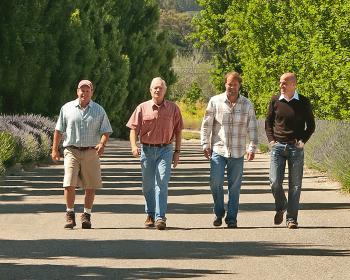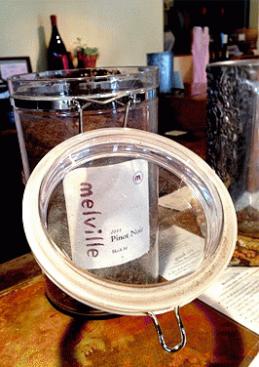| « Previous | News | Next » |
May 13, 2014
Call Me Ishmael - Visit to Melville in Sta. Rita Hills
When Ron Melville moved to Santa Barbara from Sonoma in 1989 to set up shop, little did he know that he’d be laying the groundwork for something of an empire. When the Melville family arrived, winegrowing in Santa Barbara County was just on the verge of a boom—10,000+ acres of grapes were planted within the next decade. Twenty-five years later, the region has earned a major reputation for cool-climate varietals, and Melville and his team are at the center of the buzz.
 With his two sons and winemaker Greg Brewer, Melville produces estate-grown Pinots, Chardonnays, Syrahs, and Viogniers with an eye toward expressing both regional and single-parcel terroir. Brewer was named one of the winemakers to watch in the 21st century by Wine and Spirits magazine, and has garnered further attention for his label, Brewer-Clifton. Produced with Steve Clifton, who also makes estate-grown Italian varietals under the Palmina label, Brewer-Clifton wines are intensely structured and made with a focus on sustainable and organic methods. These three labels—Melville, Brewer-Clifton, and Palmina—represent a family of sophisticated wines that are showing that Santa Barbara County terroir is a force to be reckoned with.
With his two sons and winemaker Greg Brewer, Melville produces estate-grown Pinots, Chardonnays, Syrahs, and Viogniers with an eye toward expressing both regional and single-parcel terroir. Brewer was named one of the winemakers to watch in the 21st century by Wine and Spirits magazine, and has garnered further attention for his label, Brewer-Clifton. Produced with Steve Clifton, who also makes estate-grown Italian varietals under the Palmina label, Brewer-Clifton wines are intensely structured and made with a focus on sustainable and organic methods. These three labels—Melville, Brewer-Clifton, and Palmina—represent a family of sophisticated wines that are showing that Santa Barbara County terroir is a force to be reckoned with.
Located 100 miles north of downtown LA, Santa Barbara has five official AVAs, each with a distinctive microclimate: Happy Canyon, Santa Maria Valley, Santa Ynez Valley, Ballard Canyon, and Sta. Rita Hills. Specifically, it’s Sta. Rita Hills in the northern part of the county that is shangri-la for cool-climate grapes. With a unique east-west orientation, the AVA is defined by cooling breezes and fog that blow in off the Pacific. The sea fog creates some of the coolest growing conditions in the state—cooler than Carneros and the Russian River. Breezes help circulate air and deter rot. The growing season is long (from February to October), and the Lompoc hills have some of the world’s largest and purest deposits of diatomaceous earth—a chalky substance consisting of fossilized hard-shelled algae, layered into the hillsides by earthquakes and volcanoes. It’s the same stuff in white cliffs of Dover, and it translates into lip-smacking minerality and salinity in the glass.
 Melville is passionate about their soil, and even have canisters of it from their various vineyards available at the tasting room for visitors to get a side-by-side visual of soil and glass. Their 139 acres of vines—16 clones of Pinot, 6 Chardonnay, 9 Syrah, and Viognier—grow in predominantly Lompoc dune sand, with various blocks possessing clay loam with shallow hard pans of Monterey shale. All wines are made entirely with estate fruit, and they manage their vineyards down to the minutiae. They practice leafing and shoot thinning to clear vines of surplus growth in the months prior to harvest. They train their vines on a vertical trellis system to provide as much sun exposure as possible. And they invest intensive research into their cover crops, which vary year by year, to provide the soil with the appropriate nutrients its lacking in a given year.
Melville is passionate about their soil, and even have canisters of it from their various vineyards available at the tasting room for visitors to get a side-by-side visual of soil and glass. Their 139 acres of vines—16 clones of Pinot, 6 Chardonnay, 9 Syrah, and Viognier—grow in predominantly Lompoc dune sand, with various blocks possessing clay loam with shallow hard pans of Monterey shale. All wines are made entirely with estate fruit, and they manage their vineyards down to the minutiae. They practice leafing and shoot thinning to clear vines of surplus growth in the months prior to harvest. They train their vines on a vertical trellis system to provide as much sun exposure as possible. And they invest intensive research into their cover crops, which vary year by year, to provide the soil with the appropriate nutrients its lacking in a given year.
The grapes are manually harvested in the middle of the night so that there’s no risk of yeasts becoming active in the fields. It buys them more time, and they don’t have to use sulphur until racking—and then only minimally. Harvest happens block by block, to ensure that the grapes have all reached the optimum ripeness.
*We sat down with Kurt Ammann, Melville’s General Manager, to get his take on vine and cellar. *
Cream: How has the drought affected viticultural practices and, in turn, the final wine in glass? How do you manage irrigation?
KA: The biggest effect of the drought so far can be seen in the small cover crop we currently have. The cover crop we use is a mixture of grasses and legumes that help impart nutrients and organic material back into the soil. We will be monitoring the vines closely to ensure the vineyard has everything it needs to remain healthy. The second thing below-normal rainfall has done or, more accurately, not done is a flushing of the soils. This area normally has low rainfall so these conditions are not as dramatic for us as vineyards in Northern California. If the drought continues longer this will be more of a concern. It is still too early to determine how much the lack of rain will reduce the 2014 crop but that is the biggest risk at this point. Water stress is actually one method used to grow smaller, more intense-flavored grapes, so we don’t think that the drought will negatively affect the quality of the wine in the glass. This year we did begin drip irrigation earlier than other years when we have received more rainfall. Lastly we monitor how the vines look to determine when and how much water is needed to keep the vines healthy and happy.
Cream: I read that pressure racking and bottling follows lunar cycles, so I’m wondering if you employ other biodynamic practices?
KA: Our red wine fermentations generally also last 28 days from start to finish. I think it is fair to say that Greg considers the lunar cycles, but they are not the determining factor for all of his decisions. We do not practice other biodynamic practices like spraying silica in the vineyard.
Cream: It sounds like you guys employ pretty rigorous controls in the cellar, such as stopping malolactic fermentation midway for some cuvees and selective whole cluster fermentation for different varietals. Can you talk a bit about your process? How you come to these decisions and how they affect the different wines?
KA: With white wines we use temperature to deter ML from happen, but we do not stop ML from happening in our red wines. We feel this is the best way of conveying the unique qualities of our estate vineyards and AVA into the bottle. Greg and the Melville team believe that the wines are made in the vineyard as much or more than they are made in the winery. We only use neutral oak in our wines so there is not a lot of barrel flavors imparted into the wines. You could also say that by using neutral oak the terroir of the vineyard is more easily conveyed, too. One way we impart flavors and complexity into our wines is through the use of whole cluster fermentation. The percentage of whole clusters change depending on the varietal, vintage, clone, and the product. These decisions are made by Greg at the time of harvest, after considering the specific grapes and drawing from his previous vintage experience. Logistically, Greg is given some additional freedom because of how we ferment our red wines. All reds—Pinot Noir and Syrah—are fermented 1.5 tons at a time in small stainless steel fermentors. So if Greg is picking 4.5 tons of grapes it will be 3 separate fermentors. Greg might do 1 fermentor destemed, 1 fermentor 50 percent whole cluster, 50 percent destemed, and 1 fermentor 100 percent whole cluster. When it comes time for blending the decision is made how best to combine the 3 fermentors into the best wine possible. As I said, these decisions are made initially at harvest by Greg and then refined later the following year when the wines are being assembled into the final products. Greg, Chad Melville, and the entire Melville staff have input into determining what the final blend ultimately becomes.
Some of the highlights from their current releases:
Melville 2012 Estate Pinot Noir, Sta. Rita Hills
Made from all 16 Pinot clones. Each clone is fermented separately at cold temps, then blended by Brewer to best reflect the Sta. Rita Hills appellation as a whole. Forty percent of the grapes are fermented with stems. The total process takes about 30 days, with a 7-day cold soak, 2 weeks of fermentation, and 1 week of extended maceration. It was aged sur lie without sulfur in neutral French barrel until racking in June, then bottling in August. A pretty strawberry color in the glass. Nose expresses bright strawberry, watermelon, sandalwood. The palate is silky, with notes of roses and tea. Nice acidity.
Melville 2012 Estate Pinot Noir, Block M, Sta. Rita Hills The Block M parcel is a sun-exposed, wind-swept mesa containing botella clay. A gravitational pull on three exposed sides made from 3 exposed sides forces the roots to dig quite deep, and the subsequent fruit builds significant concentration. Made from 3 clones and fermented with 80 percent stem. Fuller-bodied with aromas of raspberry, currants, cinnamon, and stone. The tannins and acid provide beautiful structure.
Melville 2012 Viognier, Verna’s, Santa Barbara Verna’s Vineyard is a 100-acre plot in Cat Canyon. Seven acres are planted to Viognier on sandy and nutrient-deficient soils. The fruit was gently pressed in whole clusters, transferred to neutral barrels, and cold fermented for three months. No malolactic fermentation. The nose is floral with rose petals, lime, tangerine, and kiwi. Beeswax notes and glycerol on the palate create a roundness. Very dry finish on a floral note.
Melville 2011 Estate Syrah, Verna’s, Santa Barbara Made from 7 different clones and fermented with 40 percent stem inclusion. Total skin and stem contact was 30 days. Wine was transferred into 10-year-old French oak where it remained sur lie without sulfur until May. Aromas of pepper, cocoa, baking spice, bbq meats on the nose lead to a soft palate with notes of clove and herbs.
